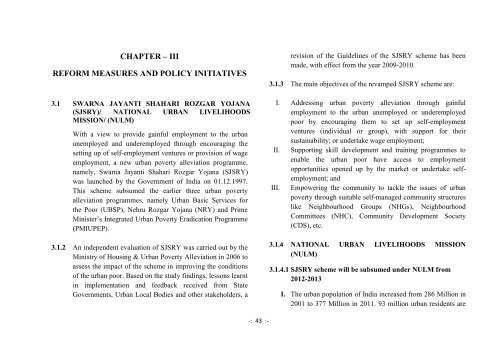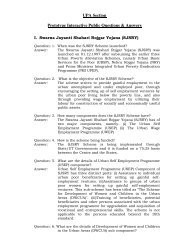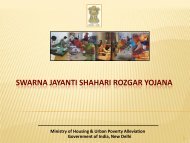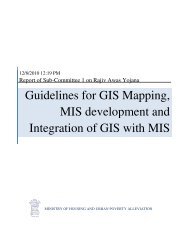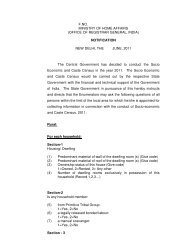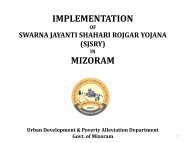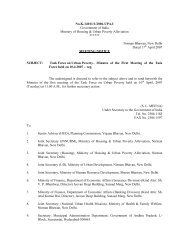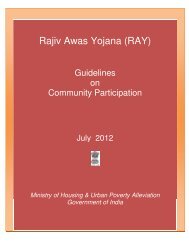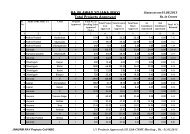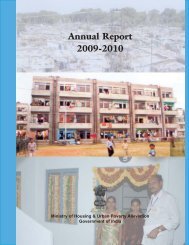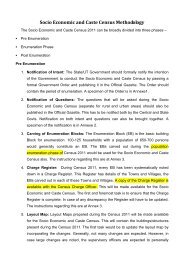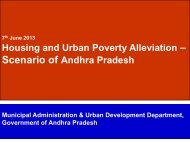Reform Measures and Policy Initiatives - Ministry of Housing ...
Reform Measures and Policy Initiatives - Ministry of Housing ...
Reform Measures and Policy Initiatives - Ministry of Housing ...
You also want an ePaper? Increase the reach of your titles
YUMPU automatically turns print PDFs into web optimized ePapers that Google loves.
CHAPTER – IIIREFORM MEASURES AND POLICY INITIATIVES3.1 SWARNA JAYANTI SHAHARI ROZGAR YOJANA(SJSRY)/ NATIONAL URBAN LIVELIHOODSMISSION/ (NULM)With a view to provide gainful employment to the urbanunemployed <strong>and</strong> underemployed through encouraging thesetting up <strong>of</strong> self-employment ventures or provision <strong>of</strong> wageemployment, a new urban poverty alleviation programme,namely, Swarna Jayanti Shahari Rozgar Yojana (SJSRY)was launched by the Government <strong>of</strong> India on 01.12.1997.This scheme subsumed the earlier three urban povertyalleviation programmes, namely Urban Basic Services forthe Poor (UBSP), Nehru Rozgar Yojana (NRY) <strong>and</strong> PrimeMinister‟s Integrated Urban Poverty Eradication Programme(PMIUPEP).3.1.2 An independent evaluation <strong>of</strong> SJSRY was carried out by the<strong>Ministry</strong> <strong>of</strong> <strong>Housing</strong> & Urban Poverty Alleviation in 2006 toassess the impact <strong>of</strong> the scheme in improving the conditions<strong>of</strong> the urban poor. Based on the study findings, lessons learntin implementation <strong>and</strong> feedback received from StateGovernments, Urban Local Bodies <strong>and</strong> other stakeholders, arevision <strong>of</strong> the Guidelines <strong>of</strong> the SJSRY scheme has beenmade, with effect from the year 2009-2010.3.1.3 The main objectives <strong>of</strong> the revamped SJSRY scheme are:I. Addressing urban poverty alleviation through gainfulemployment to the urban unemployed or underemployedpoor by encouraging them to set up self-employmentventures (individual or group), with support for theirsustainability; or undertake wage employment;II. Supporting skill development <strong>and</strong> training programmes toenable the urban poor have access to employmentopportunities opened up by the market or undertake selfemployment;<strong>and</strong>III. Empowering the community to tackle the issues <strong>of</strong> urbanpoverty through suitable self-managed community structureslike Neighbourhood Groups (NHGs), NeighbourhoodCommittees (NHC), Community Development Society(CDS), etc.3.1.4 NATIONAL URBAN LIVELIHOODS MISSION(NULM)3.1.4.1 SJSRY scheme will be subsumed under NULM from2012-2013I. The urban population <strong>of</strong> India increased from 286 Million in2001 to 377 Million in 2011. 93 million urban residents are-: 43 :-
estimated to be slum-dwellers. The number <strong>of</strong> urban poor inIndia was estimated to be 81 Million in 2004-05 based onNSSO data. The figure indicates the percentage <strong>of</strong> urbanpoor at 25.7%. What is disturbing is the fact that in spite <strong>of</strong>the impressive growth <strong>of</strong> the Indian economy, the number <strong>of</strong>urban poor has gone up by 4 Million between 1993-94 <strong>and</strong>2004-05.II. Urban India contributes to about 2/3 rd <strong>of</strong> the country‟s GrossDomestic Product (GDP). However, country-wide, morethan 3/4 th <strong>of</strong> the urban population are engaged in theinformal sector, with lack <strong>of</strong> education <strong>and</strong> proper skills,without any social security safety net <strong>and</strong> with precariousworking conditions. The number <strong>of</strong> the urban poor is solarge that even if a small increase in their productivity inwage <strong>and</strong> self-employment will lead to a huge augmentation<strong>of</strong> economic growth while contributing significantly toinclusion. Skill development will be the key to theenhancement in productivity <strong>of</strong> this segment. Selfemploymentwill also need to be addressed as the bulk <strong>of</strong> theurban poor are engaged in the urban informal sector <strong>and</strong> withincreasing urbanisation, there will be increasing jobopportunities in the informal sector.III.Prime Minister‟s National Council on Skills Developmenthas set a target <strong>of</strong> skilling <strong>of</strong> 500 million people in India by2022, mainly by fostering public-private initiatives in skilldevelopment. A significant part <strong>of</strong> this target will have to be-: 44 :-IV.linked to the newly emerging job opportunities in thegrowing urban economies. A large chunk people at thebottom <strong>of</strong> the pyramid, especially the urban poor <strong>and</strong> thelower income groups will need to be specially targeted.Based on the learning from the Swarna Jayanti ShahariRozgar Yojana, being implemented from 1997 <strong>and</strong>experience gained in the implementation <strong>of</strong> National RuralLivelihoods Mission (NRLM), the <strong>Ministry</strong> <strong>of</strong> <strong>Housing</strong> &Urban Poverty Alleviation has accordingly proposed„National Urban Livelihoods Mission (NULM)‟ to replacethe ongoing scheme <strong>of</strong> SJSRY in the 12 th Plan. Thecomponents proposed for NULM are:A. Social Mobilisation <strong>and</strong> Institutional Development(SM&ID) with sub-components:i. Building Community Institutions - SHGs <strong>and</strong> theirFederations;ii.iii.Universal Financial Inclusion; <strong>and</strong>Revolving Fund Support to SHGs <strong>and</strong> their Federations.B. Capacity Building <strong>and</strong> Training (CB&T) with subcomponents:i. Technical Support at National, State, District <strong>and</strong> CityLevels;
ii.iii.Service Centres/Aadhar Kendras at City Level; <strong>and</strong>Training <strong>and</strong> Other Capacity Building SupportC. Employment through Skills Training <strong>and</strong> Placement(EST&P)i. Skills Training for Self-Employment;ii.iii.Skills Training & Placement for Wage Employment;Innovative & Special ProjectsD. Self-employment Programme (SEP):i. Individual Enterprises (SEP-I);ii.iii.Group Enterprises (SEP-G); <strong>and</strong>Technology, Marketing <strong>and</strong> Other Support.V. In consonance with the targets set forth by the PM‟s NationalCouncil on Skill Development, NULM proposes to cover atarget <strong>of</strong> 5 Million under Skills Training & Placement, 1Million under Self-Employment - Individual <strong>and</strong> Group <strong>and</strong>1 Million under Self-Help Groups (SHGs), with appropriatetechnology, marketing, capacity building <strong>and</strong> other support,such as through Micro Business Centres at cluster level <strong>and</strong>Aadhar Kendra/Service Centre at the city level.The total fund requirement under NULM for the 12th Five YearPlan is proposed to be Rs. 20,000 crores as follows:Sl No. Financial Component Allocation<strong>of</strong> CentralFunds1. CommunityMobilizationInstitutionalDevelopment<strong>and</strong>Allocation for 12 thPlan (` incrore)10% 20002. Capacity Building & 20% 4000Training3. Employment throughSkills Training <strong>and</strong>Placement (Centralcomponent 10%, StateComponent 10%, 40% 8000District/CityComponent 15%,Special/InnovativeProjects 5%)4. Self-EmploymentProgramme -Individual & Group25% 5000Enterprises5. Administrative <strong>and</strong>1000Other Expenses 5%Total 100% 20000-: 45 :-
3.2.1 INTEGRATED LOW COST SANITATION (ILCS)The "Integrated Low Cost Sanitation" Scheme basically aimat conversion <strong>of</strong> individual dry latrine into pour flush latrinethereby liberating manual scavengers from the age old,obnoxious practice <strong>of</strong> manually carrying night soil.3.2.2 ILCS Scheme was initially started in 1980-81 through the<strong>Ministry</strong> <strong>of</strong> Home Affairs <strong>and</strong> later through <strong>Ministry</strong> <strong>of</strong>Social Justice <strong>and</strong> Empowerment. The scheme wastransferred in 1989-90 to <strong>Ministry</strong> <strong>of</strong> Urban Development<strong>and</strong> Poverty Alleviation <strong>and</strong> from 2003-04 onwards to<strong>Ministry</strong> <strong>of</strong> UEPA/HUPA which revised the guidelines w.e.f.17 th January 2008.3.2.3 Salient features:The Salient features <strong>of</strong> the revised guidelines <strong>of</strong> the Schemeare as follows:I. The objective <strong>of</strong> the Scheme is to convert/construct low costsanitation units through sanitary two pit pour flush latrineswith superstructures <strong>and</strong> appropriate variations to suit localconditions (area specific latrines) <strong>and</strong> construct new latrineswhere EWS Household have no latrines.II.III.The scheme is on „All Town‟ coverage basis irrespective <strong>of</strong>the population criteria. The Scheme is limited to EWShouseholds only.Targets will be fixed initially in the ratio <strong>of</strong> 75% forconversion <strong>of</strong> dry latrines with reference to 6 lacs dry-: 46 :-IV.latrines reported by the States so far <strong>and</strong> 25% for provision<strong>of</strong> pour flush latrines to beneficiaries having no latrines.The scheme will be funded in the following manner:-Central Subsidy 75%, State Subsidy 15% <strong>and</strong> beneficiaryshare10%.V. The upper ceiling cost <strong>of</strong> Rs. 10,000/- is provided for thecomplete unit <strong>of</strong> a two pit pour flush individual latrine withsuperstructure (excluding States falling in difficult / hillyareas). For the States falling in the category <strong>of</strong> difficult <strong>and</strong>hilly areas, 25% extra cost is provided for each two pit pourflush latrine. The Scheme is limited to EWS householdsonly <strong>and</strong> does not entail a loan component. The scheme willbe implemented by <strong>Ministry</strong> <strong>of</strong> <strong>Housing</strong> & Urban PovertyAlleviation directly.VI. The States should select NGOs having adequate experiencein this field who will be funded to a maximum extent <strong>of</strong>15% over <strong>and</strong> above the total project cost to be borne by theCentre <strong>and</strong> States based on the ratio <strong>of</strong> 5:1 at different stages<strong>of</strong> implementation.VII.1% <strong>of</strong> total central allocation will be retained by the<strong>Ministry</strong> every year, to be utilized for MIS, MonitoringSystem, Capacity Building <strong>and</strong> IEC components.
3.2.4 Present Position:The m<strong>and</strong>ate <strong>of</strong> the scheme was conversion <strong>of</strong> dry latrineswhich has been fully achieved with total sanction <strong>of</strong> projectsfor conversion <strong>of</strong> all dry latrines reported by StateGovernments. Government <strong>of</strong> India had sanctioned projectsfor conversion <strong>of</strong> 2,51,963 dry latrines <strong>and</strong> it has beenconfirmed by the States that the task has been completed <strong>and</strong>they are dry latrines free.Out <strong>of</strong> the funds available for construction <strong>of</strong> sanitarylatrines to Economically Weaker Sections (EWS)households, who do not have any Sanction for newconstruction has been given to 1,70,337 units out <strong>of</strong> which15,246 has been completed 1,55,091 are stated to be inprogress.Since the objective for which the scheme has beenpromulgated, is completed, it is proposed to seek only carryover budget to meet the committed liabilities for sanctionedprojects. In order to provide for committed liabilities foralready sanctioned projects, it is proposed to seek a carryover budget <strong>of</strong> Rs. 25.00 crore during the next FinancialYear 2012-13.3.3.1 NATIONAL SCHEME FOR SUPPORT TO STREETVENDORSThe <strong>Ministry</strong> <strong>of</strong> <strong>Housing</strong> & Urban poverty Alleviationproposes to launch a separate scheme for urban street-: 47 :-vendors in the 12th Five year plan to provide them support<strong>and</strong> incentivize implementation <strong>of</strong> National <strong>Policy</strong> on UrbanStreet Vendors <strong>and</strong> adoption <strong>of</strong> a Central law. The proposedscheme is to cover components like support for conduct <strong>of</strong>survey <strong>of</strong> Street vendors & vending space, registration,database maintenance, issue <strong>of</strong> identity card, demarcation <strong>of</strong>vending zones etc; development <strong>of</strong> vendors markets;upgradation <strong>of</strong> the quality <strong>of</strong> street food; micr<strong>of</strong>inance tostreet vendors; support for skill training etc.3.4.1 NATIONAL PROGRAMME FOR URBAN HOMELESS(NPUH)Based on National Advisory Council (NAC)‟srecommendations, this <strong>Ministry</strong> has prepared a conceptpaper on National Programme for Urban Homeless (NPUH)to build permanent shelters for the urban homeless people.These homeless shelters are proposed to be all weather <strong>and</strong>24 hours shelters with basic amenities for a life with dignity.3.4.2 The salient features <strong>of</strong> the proposed scheme are as under:Composite shelters with toilets, bathrooms, communitykitchens <strong>and</strong> other spaces for education, training, health care<strong>and</strong> entertainment as per the actual requirements. These willbe in the nature <strong>of</strong> dormitories/hall with plain floors to beused for sleeping at night as well as rest during the day time.The scheme encourages separate enclosures for families,working men <strong>and</strong> women <strong>and</strong> their dependent children.
The State Governments through its implementing agenciesincluding Urban Local Bodies will bring in l<strong>and</strong> as theircontribution.The State Governments or any agency identified by themwill commit to fund operation <strong>and</strong> maintenance costs.Government <strong>of</strong> India would fund 75% <strong>of</strong> the entire cost <strong>of</strong>construction <strong>of</strong> the shelter for the houseless at the currentCentral PWD rates applicable to the region where theconstruction is proposed. 25% would be State contribution.The selection <strong>of</strong> the viable projects, design, projectimplementation <strong>and</strong> monitoring at the State level should bedone by a committee <strong>of</strong> State Secretaries consisting <strong>of</strong>Secretaries <strong>of</strong> Urban Development, <strong>Housing</strong>, Social Welfare<strong>and</strong> Health Departments <strong>and</strong> representative <strong>of</strong> State PWD.The shelters must be in sufficient numbers to meet the needin the ratio <strong>of</strong> about one per lakh <strong>of</strong> population, in everymajor urban centre with a capacity <strong>of</strong> 100 persons or as perthe local needs.The proposed Shelter should provide, for basic facilities suchas beds <strong>and</strong> bedding, toilets, potable drinking water,community kitchens <strong>and</strong> also provide, as far as feasible,lockers, first aid, primary health, de-addiction <strong>and</strong> recreationfacilities.The shelters should be permanent, running through out theyear; <strong>and</strong> open round the clock, because many homelesspersons find work in the nights.A space <strong>of</strong> 5 sq. meters per person is being proposed forhomeless shelters, at the minimum.The Community Kitchens may be run by the State agenciesor any private agencies for provision <strong>of</strong> healthy <strong>and</strong> hygienicfood at affordable rates to the poor. Voluntary participation<strong>of</strong> the beneficiaries should be encouraged to bring in a sense<strong>of</strong> ownership.3.4.3 Financial implications:The financial implications <strong>of</strong> the scheme would beaccurately worked out once the actual details <strong>of</strong> the urbanhouseless are available through the census <strong>of</strong> India, 2011data, keeping in mind the current CPWD rates. However arough estimate shows that: as per the census 2001 data, thereare nearly 7.7 lakh urban houseless population. Initialestimates show that the total cost for construction <strong>of</strong> requiredshelters is approximately, Rs. 5180.175 crores. Adding atleast 1% <strong>of</strong> the cost <strong>of</strong> administrative <strong>and</strong> miscellaneousexpenses, the total scheme would cost Rs. 5231.976 crores orapproximately Rs. 5230 crores at current rates. At the ratio<strong>of</strong> 75% <strong>of</strong> the cost being Central Subsidy the plan outlay forthe scheme during the 12 th plan period would be Rs. 3922.5-: 48 :-
crores or Rs. 3923 crores. This would work out to nearly Rs.785 crores per annum during the 12 th Five Year Plan period.The concept paper on the scheme has been sent to thePlanning Commission.3.5 URBAN STATISTICS FOR HR AND ASSESSMENTSCHEME (USHA)3.5.1 A new Central Sector Scheme „USHA‟ was approved by theEFC under the chairmanship <strong>of</strong> Secretary (HUPA) in itsmeeting held on 22 nd August, 2007. The scheme was a part<strong>of</strong> NBO activities during the 10 th Five Year Plan. EFC underthe chairmanship <strong>of</strong> Secretary (HUPA) approved inclusion<strong>of</strong> the scheme in the 11 th Five Year Plan based ondiscussions with the Planning Commission which agreed toenhance budget for 2007-08 considering the need fordeveloping a national statistical system on buildingconstruction, housing, slums <strong>and</strong> urban poverty <strong>and</strong> thechallenges <strong>of</strong> data base <strong>and</strong> MIS support for JNNURM. TheScheme is proposed to be continued in the 12 th five year Planas well.3.6 INTEREST SUBSIDY SCHEME FOR HOUSING THEURBAN POOR (ISSHUP)3.6.1 In the National Urban <strong>Housing</strong> & Habitat <strong>Policy</strong>, 2007 adem<strong>and</strong> driven approach, ranging from subsidy basedhousing schemes to cost recovery-cum-subsidy schemes forhousing through a pro-active financial policy includingmicro-finance <strong>and</strong> related self–help group programmes, hasbeen advocated. The policy seeks to devise innovativehousing finance schemes for targeting the two segments –EWS & LIG with suitable support from Central <strong>and</strong> StateGovernments to increase flow <strong>of</strong> finance for catering tohousing needs <strong>of</strong> these segments.I. To achieve the said objective, the Government had approvedan Interest Subsidy Scheme for <strong>Housing</strong> the Urban Poor(ISHUP) to be implemented in the 11 th Five Year Plan as onpilot basis. The interest subsidy scheme was aimed tosupplement the efforts <strong>of</strong> the Government through theJNNURM to comprehensively address the housing shortage.The interest subsidy on housing loans for the urban poor willenhance affordability besides leveraging funds from themarket for lower segments. Under this scheme, a subsidy <strong>of</strong>5 per cent per annum will be given for loans <strong>of</strong> Rs 100,000/-taken during the 11th Plan. The loan repayment periodwould be 15-20 years.II. The Interest Subsidy Scheme for <strong>Housing</strong> the Urban Poor(ISHUP) was launched w.e.f. 26/12/2008 with a view to-: 49 :-
III.enable access <strong>of</strong> urban poor to the long term institutionalfinance. The Scheme seeks to provide interest subsidy toEconomically Weaker Section (EWS) (income uptoRs.5000/-) <strong>and</strong> Low Income Group (LIG) (income from Rs.5001 – Rs. 10000/) beneficiaries on availing loans from theBanks /<strong>Housing</strong> Finance Companies (HFCs) to enhanceaffordability <strong>of</strong> these income segments. Under this scheme,an interest subsidy <strong>of</strong> 5 percent per annum will be givenupfront on loans up to Rs. 1,00,000/- taken from Banks /<strong>Housing</strong> Finance Companies (HFCs) during 11th Five YearPlan. The Loan repayment Period would be 15-20 years. Thetotal plan outlay for the scheme was Rs.1,100crores. TheScheme was to be implemented as a pilot initially, <strong>and</strong> wasto be reviewed after two years.Cumulatively, till December,2011 only 8,734 beneficiariesin Andhra Pradesh, Chhattisgarh, Karnataka, MadhyaPradesh, Maharashtra, Rajasthan, Tamil Nadu, Uttar Pradesh<strong>and</strong> Kerala have been covered under the Scheme <strong>and</strong> totalNPV <strong>of</strong> interest subsidy <strong>of</strong> Rs. 7.57 crore has been released.Since June 2011, ISHUP has been dovetailed with theGovernment's flagship Mission <strong>of</strong> Rajiv AwasYojana (RAY)for a Slum free India. In order to reach out to the targetedbeneficiaries<strong>Ministry</strong> is in the process <strong>of</strong> formulaitngInterest Subsidy Scheme for <strong>Housing</strong> the Urban Poor(ISHUP) into revised forms to be implemented in the 12thFive Year Plan (2012-17) viz.,3.6.2 REVISED INTEREST SIBSIDY SCHEME FORHOUSING THE URBAN POOR (ISHUP)I REVISED INTEREST SIBSIDY SCHEME FORHOUSING THE URBAN POOR (ISHUP) : Under thisscheme existing loans upto Rs. 1.0 lakh with an interestsubsidy <strong>of</strong> 5% would be provided to JNNURM & RAYbeneficiaries along with capital subsidy as is being extendedto Indira Awas Yojana(IAY) beneficiaries under DifferentialRate <strong>of</strong> Interest (DRI) scheme.Further, it is proposed to provide loans upto Rs. 1.0 lakh forextension <strong>of</strong> existing houses to overcome the acute shortage<strong>of</strong> housing due to congestion factor <strong>and</strong> conversion <strong>of</strong> semipuccahouses into pucca houses.II RAJIV RIN YOJANA: For those Economically WeakerSections (EWS) /Low Income Group (LIG) households, whoare not beneficiaries under RAY or JNNURM, it is proposedto provide loans to the extent <strong>of</strong> Rs. 2.0 lakh & Rs. 4.0 lakh-: 50 :-
in order to realistically finance the increasing cost <strong>of</strong> housingin urban areas.A sum <strong>of</strong> Rs. 5,000 crore is proposed to be earmarked out <strong>of</strong>ACA funds allocated to RAY to finance these two streams <strong>of</strong>Interest Subsidy Scheme for <strong>Housing</strong> the Urban Poor(ISHUP) viz. Revised ISHUP & RRY.IIIIISystem <strong>of</strong> Committee Meetings to review the ongoing workon regular basis <strong>and</strong> to establish a structured communicationsystem with the <strong>of</strong>ficers <strong>of</strong> the Council.On the pursuance <strong>of</strong> the <strong>Ministry</strong>, the legal documents <strong>of</strong> theCouncil such as Bye-laws, delegation <strong>of</strong> powers <strong>and</strong>recruitment-cum-promotion rules have been amended in thelight <strong>of</strong> the recommendations <strong>of</strong> the 6 th Pay Commission.3.7 BUILDING MATERIALS & TECHNOLOGYPROMOTION COUNCIL (BMTPC)3.7.1 BMTPC has initiated the following measures forstrengthening its intermediate outputs:IWith the opening <strong>of</strong> economy <strong>and</strong> consequent risinginvestments in industrial sector, building materials <strong>and</strong>construction industry has also gradually attractedinvestments both from Indian <strong>and</strong> foreign entrepreneurshigher than before during recent years. In keeping with them<strong>and</strong>ate <strong>of</strong> BMTPC to stimulate <strong>and</strong> facilitate action atvarious levels, the Council has been learning from the risingdem<strong>and</strong>s on its tasks from different segments <strong>of</strong> users. Suchtasks, interalia, include domestic <strong>and</strong> foreign investment,stimulating information flows <strong>and</strong> developing supportfunctions <strong>and</strong> improving infrastructure to meet the changingneeds <strong>of</strong> housing <strong>and</strong> building construction sector.3.8 INSTITUTIONAL DEVELOPMENT FOR INCLUSIVEURBAN GOVERNANCE3.8.1 This Scheme will extend support for establishment <strong>of</strong>National <strong>and</strong> State Institutes to promote inclusive urbangovernance through comprehensive programmes <strong>of</strong>degree/diploma in urban management/trainingprogrammes/h<strong>and</strong>holding/research <strong>and</strong> IEC activities. Thescheme proposed is to have a national institute as a thinktank to Central Ministries <strong>and</strong> States on the paradigm <strong>of</strong>inclusive governance, 5 Indian Institutes <strong>of</strong> Urbanmanagement as recommended by the High Power ExpertCommittee (HPEC) in collaboration with States <strong>and</strong> StateInstitutes.-: 51 :-
3.9 CAPACITY BUILDING FOR URBANDEVELOPMENT PROJECT (WORLD BANKASSISTANCE)3.9.1 The Capacity Building for Urban Development Projectsupported through World Bank aims to help the Governmentaddress the major constraints to urban development <strong>and</strong>specifically focuses on the capacity building requirementsfor successful urban management <strong>and</strong> poverty reduction. Theproject will provide support for capacity building at thenational <strong>and</strong> local levels in the areas <strong>of</strong> urban management<strong>and</strong> poverty monitoring <strong>and</strong> alleviation. The project‟sdevelopment objective is that: selected ULBs will haveimproved their systems <strong>and</strong> skills for urban management <strong>and</strong>urban poverty reduction.The project will be implemented from November 1, 2011 toJune 30, 2016. Project has two components:I. Capacity Building for Strengthened Urban ManagementII. Capacity Building for Effective Urban PovertyMonitoring <strong>and</strong> AlleviationMoUD <strong>and</strong> MoHUPA will be the implementing agenciesunder Component I <strong>and</strong> II respectively. The total fundsavailable under component one is USD 40 million <strong>and</strong>component two is USD 20 million.3.9.2 Intended Outputs-: 52 :-Capacity Building for Effective Urban PovertyMonitoring <strong>and</strong> Alleviation component will support inbuilding capacities at the central <strong>and</strong> local levels for policyformulation, implementation <strong>and</strong> monitoring, in the area <strong>of</strong>urban poverty alleviation with special focus on building-upinformation systems, fostering knowledge <strong>and</strong> informationexchange <strong>and</strong> learning, including designing <strong>and</strong>institutionalizing mechanisms to promote communityparticipation in implementing urban poverty alleviationprograms. The project will target 20 ULBs for acomprehensive package <strong>of</strong> assistance on urban management<strong>and</strong> poverty reduction. Following will be the specificoutputs under this component:Challenge Fund for Urban Poverty Alleviation. Support willbe provided to ULBs working on urban poverty alleviationthrough recognizing <strong>and</strong> awarding innovative practices inthis area; <strong>and</strong> also who are interested in adopting <strong>and</strong> scalingup one or more identified good practice.Creation <strong>of</strong> a Practitioners Network Support will be providedby constituting a network <strong>of</strong> practitioners with the objective<strong>of</strong> promoting information sharing <strong>and</strong> capacity building. Thenetwork will also facilitate the dissemination <strong>and</strong> discussion<strong>of</strong> best practices identified <strong>and</strong>/or developed through theChallenge Fund.Strengthening a National level Training Institute Supportwill be provided to a National Institute by strengthening it to
e a premier apex training institute with focus on buildingcapacities in urban poverty alleviation. Institutionalizing Community Development Structures.Support will be provided to cities to institutionalisecommunity development structures so as to ensurecommunity engagement in planning, implementation, <strong>and</strong>operation <strong>and</strong> management <strong>of</strong> urban poverty alleviationprograms. Strengthening <strong>of</strong> MOHUPA: Support policy analysis <strong>and</strong>development as well as build a comprehensive M&E systemin MOHUPA in coordination with ULBs.hierarchical linkage <strong>of</strong> the three levels is shown in theschematic below:Implementation Arrangements at MoHUPALevel I ProjectChaired by SecretaryManagement MoHUPABoardLevel II Project Steering Chaired by Joint SecretaryCommittee (RAY)/PD CBUD ProjectMoHUPALevel ProjectA National level commonIII Monitoring Unit PMU serving both MoUD3.9.3 Implementation arrangements<strong>and</strong> MoHUPA viarespective PMB <strong>and</strong> PSCThe project design envisages a three-tier structure forLevel 4 Selected 20 ULBsoversight. The project will be implemented through astructure <strong>of</strong> Programme Management Boards (PMBs),chaired by the Secretary <strong>of</strong> MOHUPA, <strong>and</strong> also comprisingrepresentatives from the Department <strong>of</strong> Economic Affairs(DEA) <strong>and</strong> the Planning Commission. PMB will provide3.9.4 Major Expected Outcomesoverall oversight <strong>and</strong> guidance, as well as approve majorULB‟s provided support under replication/up-scaling <strong>of</strong>work plans <strong>and</strong> activities. PMB will be supported by apoverty alleviation programmes demonstrate effectiveProject Steering Committee (PSC), which will be chaired byimpact <strong>of</strong> investmentsthe Joint Secretary <strong>and</strong> will also have representation from the• Focus on institutional <strong>and</strong> organisational strengtheningDEA <strong>and</strong> the Planning Commission. PSC will in turn bethrough knowledge sharing as well as the development <strong>of</strong>supported by the single national level PMU, which isindividual competencies <strong>and</strong> skills.established under the project for providing technical <strong>and</strong>managerial support during project implementation. The-: 53 :-
• Cities start engaging with communities in planning <strong>and</strong>implementation <strong>of</strong> Urban Poverty Alleviation programs.3.9.5 FundingThe total support under this project is <strong>of</strong> 20 million USD,which is approx. Rs. 100 crores. As activities under theproject have commenced only from November 2011, thebudget till March 2012 is Rs. 50 lakh.3.10 SUPPORT TO NATIONAL POLICIES FOR URBANPOVERTY REDUCTION (GOI-DFID PROJECT)Committee (PSC) was held on 11 th August 2011. Theoverall Goal <strong>of</strong> the project is „A sustained reduction inurban poverty’. The following are the expected outputs <strong>of</strong>the project:Output 1: Institutional co-ordination between M/o UD <strong>and</strong>M/o HUPA strengthened.Output 2: <strong>Policy</strong> <strong>and</strong> Programme Support Unit (PPSU) inMo/ HUPA developing <strong>and</strong> disseminating policy on urbanpoverty reduction <strong>and</strong> pro-poor governance, learning fromState experiences.3.10.1 In a context <strong>of</strong> economic growth accompanied by on-goingurbanisation, this project seeks to support the Government <strong>of</strong>India‟s (GoI) response to the twin challenges <strong>of</strong> increasingurban poverty <strong>and</strong> weak local government. Specifically itwill support more effective, poverty-focused implementation<strong>of</strong> the Rajiv Awas Yojana (RAY), Jawaharlal NehruNational Urban Renewal Mission (JNNURM) <strong>and</strong> theSwarna Jayanti Shahari Rozgar Yojana (SJSRY).The agreement for the GoI-DFID Project, Support toNational Policies for Urban Poverty Reduction (SNPUPR)was signed in April 2010 between DEA, M/o Finance <strong>and</strong>DFID. The project was initiated from July 2010 <strong>and</strong> staff putin place by December 2010. The first meeting <strong>of</strong> theProgramme Management Board (PMB) was held on 1 stDecember 2010 <strong>and</strong> the first meeting <strong>of</strong> the Project Steering-: 54 :-Output 3: A Network <strong>of</strong> Resource Centres is created whichsupports pro-poor urban policy development <strong>and</strong> programmeimplementation.Output 4: Capacities <strong>of</strong> selected State <strong>and</strong> city/towngovernments are strengthened to effectively implement propoorreforms <strong>and</strong> programmes.The project has been supporting the <strong>Ministry</strong> in theimplementation <strong>of</strong> its programme by providing technicalsupport in formulation <strong>of</strong> technical guidelines <strong>and</strong> capacitybuilding <strong>of</strong> 20 selected cities.3.11 JAWAHARLAL NEHRU NATIONAL URBANRENEWAL MISSION (JNNURM)3.11.1 Special features <strong>of</strong> integrated development <strong>of</strong> slums
Both under BSUP <strong>and</strong> IHSDP emphasis is given forintegrated development <strong>of</strong> slums through projects forproviding shelter, basic services <strong>and</strong> other related civicamenities with a view to provide amenities <strong>and</strong> entitlementsto the urban poor. Accordingly, the approved projectsinclude physical amenities <strong>and</strong> related infrastructure such aswater supply, sewerages, storm water drain, roads, multipurposecommunity centers, parks, etc.3.11.2 BSUP <strong>and</strong> IHSDP components <strong>of</strong> JNNURM emphasisethe following 3 Pro-Poor Key <strong>Reform</strong>s: Internal earmarking within local body budgets for BasicServices to the Urban Poor:-56 cities have undertaken implementation <strong>of</strong> this reform.This reform is to be implemented in a staggered mannerover the Mission Period in convergence with theprogrammes <strong>of</strong> other Ministries as this is also anoutcome <strong>of</strong> the Mission.3.11.3 Mission Achievements as on 2.1.2012Physical Progrees• All States covered under BSUP• All 65 Mission cities covered <strong>and</strong> 882 medium <strong>and</strong> smallcities/towns covered under IHSDP (other than the 65)• 1517 projects approved for providing housing <strong>and</strong> basicamenities to the urban poorEarmarking <strong>of</strong> at least 20-25% <strong>of</strong> developed l<strong>and</strong> in allhousing projects (both public <strong>and</strong> private agencies) forEWS/LIG category:-22 States (51 Cities) have issued the policy directives toreserve developed l<strong>and</strong> in public <strong>and</strong>/or private housingprojects.• More than 1.57 million houses sanctioned (15,70,926)• About 5.24 lakh houses completed <strong>and</strong> 3.74 lakh houses inprogress. Out <strong>of</strong> the completed houses, 3.20 lakh housesoccupied.• Progress <strong>of</strong> 3 key reforms under JNNURM largely on track.Implementation <strong>of</strong> 7- Point Charter: Provision <strong>of</strong> 7 BasicEntitlements/Services:--: 55 :-3.11.4 Other Achievements• Financial support for setting up <strong>of</strong> Programme ManagementUnits (PMUs) in 29 States/UTs has been approved to assist
States in monitoring BSUP, IHSDP <strong>and</strong> other urban povertyalleviation/slum development schemes.• Financial support for setting up <strong>of</strong> 124 ProjectImplementation Units (PIUs) has also been approved at theCity/ULBs levels to assist cities/project implementingagencies in monitor BSUP, IHSDP <strong>and</strong> other urban povertyalleviation/slum development schemes.• A framework for Third Party Inspection <strong>and</strong> Monitoring(TPIM) established <strong>and</strong> 30 agencies for independent thirdparty inspection <strong>and</strong> monitoring empanelled by MissionDirectorate. TPIMs for 21 States, namely Andhra Pradesh,Assam, Chhattisgarh, Delhi, Gujarat, Haryana, HimachalPradesh, Jammu & Kashmir, Karnataka, Kerala, MadhyaPradesh, Maharashtra, Manipur, Mizoram, Orissa,Puducherry, Rajasthan, Tamil Nadu, Uttar Pradesh,Uttarakh<strong>and</strong> <strong>and</strong> West Bengal have been approved.• In furtherance <strong>of</strong> the objective <strong>of</strong> ensuring quality <strong>of</strong> projectsunder BSUP <strong>and</strong> IHSDP, two Agencies have been engaged atthe Central level after selecting 126 projects on sample basisfrom the States/ULBs for purpose <strong>of</strong> TPIM by Government <strong>of</strong>India. Central TPIM also engaged for the 4 North -EasternStates <strong>of</strong> Arunachal Pradesh, Meghalaya, Sikkim <strong>and</strong> Tripura<strong>and</strong> UT <strong>of</strong> Ch<strong>and</strong>igarh to cover all their projects.• An Online JNNURM tracking system as part <strong>of</strong> an IntegratedPoverty Monitoring System (IPoMS) is developed <strong>and</strong> isunder implementation. 22 States have adopted IPoMS so far<strong>and</strong> sending key progress reports online.• States have been exhorted to start preparations for social audit<strong>of</strong> projects under BSUP & IHSDP. The Manual for SocialAudit has been circulated to States/UTs for initiating aprocess <strong>of</strong> social audit with the involvement <strong>of</strong> beneficiaries,reputed NGOs <strong>and</strong> other stakeholders. Proposals were invitedfrom National Network <strong>of</strong> Resource Centres (NNRCs) incollaboration <strong>of</strong> reputed Non-Governmental Organizations(NGOs) for conducting Social Audit Pilots <strong>of</strong> BSUP <strong>and</strong>IHSDP Projects. Social Audit Pilot reports <strong>of</strong> 5 cities (Agra,Bhopal, Ch<strong>and</strong>igarh, Ambala <strong>and</strong> Rajkot) have been received<strong>and</strong> are under examination.• Detailed Project Reports, Guidelines, Toolkits <strong>and</strong> Minutes <strong>of</strong>BSUP <strong>and</strong> IHSDP Sanctioning Committees have been put onthe website to establish transparency <strong>and</strong> sharing <strong>of</strong>information at large.• A Toolkit on financial support for comprehensive capacitybuilding programme for improved urban governance <strong>and</strong>poverty alleviation has been developed <strong>and</strong> circulated to allState/UT Governments. Financial assistance is being providedfor training <strong>and</strong> capacity building programmes for personnelat various levels <strong>and</strong> supporting the establishment <strong>of</strong>-: 56 :-
National/Regional/State Urban Resource Centers to promotethe development <strong>of</strong> institutional capacity.• Guidelines on financial support for funding various activitiesrelated to „Project Implementation <strong>and</strong> Quality Assurance‟<strong>and</strong> „Community Mobilization‟ relating to BSUP/IHSDPProjects under JNNURM circulated to all States.• More than 200 capacity building/h<strong>and</strong>holding programmeshave been conducted across the country <strong>and</strong> about 17000State/parastatal/local body <strong>of</strong>ficials trained in projectformulation, design, <strong>and</strong> implementation <strong>and</strong> monitoring.3.12 RAJIV AWAS YOJANA3.12.1 Rajiv Awas Yojana (RAY) is aimed at making India Slumfreebased on Slum-free State <strong>and</strong> Slum-free City Plans. Thescheme is in pursuance <strong>of</strong> the following announcements bythe Government:President <strong>of</strong> India - Address to both the Houses <strong>of</strong>Parliament on 4 th June 2009:“My Government proposes to introduce a Rajiv Awas Yojanafor the slum dwellers <strong>and</strong> the urban poor on the lines <strong>of</strong> theIndira Awas Yojana for the rural poor. The schemes foraffordable housing through partnership <strong>and</strong> the scheme forinterest subsidy for urban housing would be dovetailed intothe Rajiv Awas Yojana which would extend support under-: 57 :-JNNURM to States that are willing to assign property rightsto people living in slum areas. My Government‟s effortwould be to create a slum free India in five years through theRajiv Awas Yojana.”Prime Minister in Independence Day Address to the Nationon 15 th August 2009:“We had started the Jawaharlal Nehru National UrbanRenewal Mission for the urban areas. We will accelerate thisprogramme also. Today, lakhs <strong>of</strong> our citizen live in slumswhich lack basic amenities. We wish to make our countryslum free as early as possible. In the next five years, we willprovide better housing facilities to slum dwellers through anew scheme, Rajiv Awas Yojana”.The announcement <strong>of</strong> Rajiv Awas Yojana reflects theGovernment‟s vision for inclusive urban growth throughSlum-free States <strong>and</strong> Cities <strong>and</strong> property rights as the trackon which this policy for inclusion must be directed. Thescheme envisages the ownership <strong>of</strong> the vision <strong>and</strong>programme by the States at State-led pace, so that a SlumfreeIndia as an aggregate <strong>of</strong> the vision <strong>of</strong> States for SlumFree Cities becomes a reality.3.12.2 Objective <strong>and</strong> approach under RAY1. RAY envisages creating a Slum Free India by encouragingstates to assign property rights to slum dwellers. It proposes
II.III.to address the problem <strong>of</strong> slums in a holistic <strong>and</strong> definitiveway adopting a multi-pronged approach focusing on: bringing existing slums within the formal system<strong>and</strong> enabling them to avail <strong>of</strong> the same level <strong>of</strong> basicamenities as the rest <strong>of</strong> the town; redressing the failures <strong>of</strong> the formal system that liebehind the creation <strong>of</strong> slums; <strong>and</strong> tackling the shortages <strong>of</strong> urban l<strong>and</strong> <strong>and</strong> housing thatkeeps shelter out <strong>of</strong> reach <strong>of</strong> the urban poor <strong>and</strong> forces themto resort to extra-legal solutions in a bid to retain theirsources <strong>of</strong> livelihood <strong>and</strong> employment.The overarching aim <strong>of</strong> RAY is thus be to drive afundamental change in policy <strong>and</strong> reform in the existingurban development systems to make cities inclusive <strong>and</strong>equitable. Release <strong>of</strong> funds under RAY is predicated uponthe acceptance <strong>and</strong> implementation <strong>of</strong> the followingnecessary policy actions by the states:• Assignment <strong>of</strong> the property right to slum-dwellers• Completion <strong>of</strong> Pro-poor reforms under JNNURM• Making urban development inclusive with provision<strong>of</strong> spaces for the Urban PoorThe strategy for implementation <strong>of</strong> RAY has the followingmain elements: RAY will be driven by <strong>and</strong> implemented at the paceset by the States/UTs. A „whole city‟, „whole slum‟ approach will beadopted. In each slum, an integrated approach would be taken,with provision <strong>of</strong> infrastructure, basic civic <strong>and</strong> socialamenities <strong>and</strong> decent housing. Community will be involved at every stage, fromplanning through implementation to post-projects sustenance stages. The attempt to design for people would bedone with the people. RAY will encourage flexibility to states <strong>and</strong> cities indeciding solutions specific to the requirements <strong>of</strong> each slum,whether upgrading, redevelopment, or in unavoidable cases,relocation. Multiple choices <strong>and</strong> models for housing wouldbe encouraged. In-situ development will be the programme <strong>of</strong>choice, to ensure that development does not lead to a loss <strong>of</strong>job linkage or additional hours <strong>and</strong> income lost oncommuting to work.-: 58 :-
Private sector participation will be emphasised underRAY, for slum redevelopment, wherever feasible, as well asfor creation <strong>of</strong> new affordable housing stock, both for rental<strong>and</strong> ownership. The benefits <strong>of</strong> health, education, social security,worker‟s welfare, livelihood <strong>and</strong> public transport linkagesfor holistic slum redevelopment will be provided throughconscious effort for convergence <strong>of</strong> schemes <strong>and</strong> dovetailing<strong>of</strong> budgetary provisions available under the programmes inthe respective sectors.3.12.3 Slum-free City Planning Scheme under RAYAs a precursor to RAY, the preparatory phase was initiatedfrom March, 2010 under the Slum-free City PlanningScheme. Under the Scheme the States are being assisted todraw up their Slum-free Plans <strong>of</strong> Action to proceed towardsthe goal <strong>of</strong> Slum-free Cities/States in a systematic <strong>and</strong> timebound manner. Detailed Guidelines under the Slum FreeCity Planning Scheme were issued <strong>and</strong> the states beingprovided technical <strong>and</strong> financial assistance to prepare SlumFree City Plans. So far Rs. 99.98 Crores have been releasedto 157 cities for undertaking preparatory activities underSlum Free City Planning Scheme – the preparatory phase <strong>of</strong>Rajiv Awas Yojana.The preparatory activities include slum survey, GIS Mapping<strong>of</strong> Slums <strong>and</strong> development <strong>of</strong> Slum free City <strong>and</strong> Slum free-: 59 :-State Plans with active involvement <strong>of</strong> experts havingexpertise in the areas <strong>of</strong> GIS, MIS, Planning etc.With the approval <strong>of</strong> RAY, the preparatory activities asenvisaged under the Slum Free City Planning Scheme arebeing carried out as per guidelines <strong>of</strong> this Scheme, underRAY.3.13 BUILDING CENTRES SCHEME3.13.1 A Central Scheme to set up National Network <strong>of</strong> BuildingCentres was introduced in 1988, with the basic objectives <strong>of</strong>providing a decentralized delivery system for the training<strong>and</strong> upgradation <strong>of</strong> skills for housing activity, extension <strong>of</strong>low cost housing technology <strong>and</strong> shelter guidance,demonstration <strong>of</strong> the manufacture <strong>and</strong> use <strong>of</strong> low cost ,appropriate <strong>and</strong> indigenous based building materials <strong>and</strong>materials produced out <strong>of</strong> industrial <strong>and</strong> agricultural wastesetc. within the framework <strong>of</strong> the overall policy <strong>of</strong> Central<strong>and</strong> State Governments for technology transfer fromexperimentation to wide-spread use. The Scheme was beingimplemented through HUDCO <strong>and</strong> then discontinued. It wasthen proposed to rejunevate <strong>and</strong> implement the scheme withthe title <strong>of</strong> “Strengthening the Scheme <strong>of</strong> National Network<strong>of</strong> NirmanKendras/NirmithiKendras(Building Centres)during the 11 th Plan. The EFC cleared this proposal on20/08/2008 with an anticipated expenditure <strong>of</strong> Rs. 62.00crore.
IIIIIAn amount <strong>of</strong> Rs. 1.00 crore has been allocated as tokenallocation in BE 2011-12 against projected requirement <strong>of</strong>Rs. 62 crore for the 11 th Five Year allocations.The guidelines <strong>of</strong> the said EFC approved Scheme werehowever not issued as it was felt that instead <strong>of</strong> the buildingcenter concept the focus should be on the objectives <strong>of</strong> theproposal <strong>and</strong> other methods by which technologies can beeffectively popularized in a country as vast <strong>and</strong> varied.Accordingly, a revised Concept Paper, namely, ConfidenceBuilding in Alternate <strong>Housing</strong> Technologies was prepared<strong>and</strong> pursuant to this, the draft EFC note along with the draftguidelines was referred to the Planning Commission seekingtheir in principal approval <strong>and</strong> to tie up funds for theScheme, <strong>and</strong> to the Department <strong>of</strong> Expenditure for theircomments/concurrence.IV The Planning Commission <strong>and</strong> the Department <strong>of</strong>Expenditure conveyed their comments. The PlanningCommission, inter alia, observed that the proposed schemeappeared to be Centrally Sponsored Scheme instead <strong>of</strong>Central Sector Scheme, <strong>and</strong> that the outcome <strong>of</strong> the proposednew scheme <strong>and</strong> that <strong>of</strong> the ongoing scheme <strong>of</strong>“Strengthening <strong>of</strong> National Network on the NirmanKendras”which was approved by EFC on 20.08.2008 for Rs.62 croresare similar. Thus proposing <strong>of</strong> a new scheme when an output<strong>of</strong> such scheme match with those <strong>of</strong> already ongoingschemes does not appear to be proper. The Depart <strong>of</strong>VExpenditure had, inter alia, suggested that first we should getthe in principle approval <strong>and</strong> tie up <strong>of</strong> fund from thePlanning Commission. They have also suggested that thepossibility <strong>of</strong> synergizing the instant scheme with thefunctioning <strong>of</strong> NirmithiKendras could be considered as also<strong>Ministry</strong> may consider synergizing the effort under thepresent scheme with the existing IAY <strong>and</strong> prospective RAYSchemes. They have also requested for a clarification as towhether the responses <strong>of</strong> the State Governments have beentaken on board during the formulation <strong>of</strong> the Scheme.The matter has been examined onwards <strong>and</strong> furthermodification <strong>of</strong> the proposed Scheme, in the light <strong>of</strong> thecomments <strong>of</strong> Planning Commission <strong>and</strong> Department <strong>of</strong>Expenditure was also considered. Thereafter, it was felt thatkeeping in view the fact that the 11 th Plan was ending in2012, in the first instance, the proposed Scheme may beundertaken by BMTPC as a pilot project utilizing itsavailable funds. BMTPC, apart from the provision <strong>of</strong>grants-in-aid from the <strong>Ministry</strong> which is Rs. 5.5 croresduring 2010-11, has a reserve fund <strong>of</strong> Rs. 12.90 crores. Theproposed pilot project may include following elements:Construction <strong>of</strong> demonstration structures envisaged inthe proposed Scheme by BMTPC, involving activebuilding centers wherever feasible.-: 60 :-
VI While drawing up the operational parameters, BMTPCmay lay down specific criteria for selecting such activeBuilding Centres. The beneficiary contribution in respect <strong>of</strong> thedemonstration houses envisaged in the draft Scheme willhave to be borne by the BMTPC, <strong>and</strong> the l<strong>and</strong>,infrastructure <strong>and</strong> rest <strong>of</strong> the contributions to be met bythe States Governments under the relevant Schemes suchas JNNURM State Schemes etc. BMTPC may signMemor<strong>and</strong>um <strong>of</strong> Agreements with the StateGovernments. Depending upon the success <strong>of</strong> the pilot project aScheme would be considered during the 12 th Plan. BMTPC has been requested accordingly to submit aproposal for the pilot project.BMTPC has been working on the scheme with consultationwith its stakeholders. A token amount <strong>of</strong> Rs. 1.00 crore hasbeen allocated under this scheme for the annual plan <strong>of</strong>2012-13. The total outlay for this scheme in the 12 th Plan isRs. 10.00 crore.3.14.1 NATIONAL URBAN HOUSING AND HABITATPOLICY (NUHHP), 2007I. In order to address the issue <strong>of</strong> housing shortage, the firsturban area – specific housing policy titled the NationalUrban <strong>Housing</strong> <strong>and</strong> Habitat <strong>Policy</strong> (NUHHP) 2007 has been-: 61 :-II.formulated, which was laid on both the Houses <strong>of</strong> Parliamenton 07-12-2007. The <strong>Policy</strong> seeks to set in motion a processfor providing “Affordable <strong>Housing</strong> for All”, particularly forEconomically Weaker Section (EWS) <strong>and</strong> the Low IncomeGroup (LIG) through various types <strong>of</strong> public-privatepartnerships.It aims at promoting sustainable development <strong>of</strong> habitat inthe country with a view to ensuring equitable supply <strong>of</strong> l<strong>and</strong>shelter <strong>and</strong> services at affordable prices to all sections <strong>of</strong> thesociety. However, given the magnitude <strong>of</strong> the housingshortage <strong>and</strong> the staggering requirement <strong>of</strong> funds amountingto `3.61 lakh crore to meet the cost <strong>of</strong> construction only forovercoming the shortage, it is obvious that public sectorefforts alone will not suffice in fulfilling the requirement dueto budgetary constraints <strong>of</strong> both Central <strong>and</strong> StateGovernments. Involvement <strong>of</strong> multiple stakeholdersnamely; private sector, co-operative sector, industrialsector for labour housing <strong>and</strong> the services, institutionalsector for employee housing has been emphasised in theNUHHP. The <strong>Policy</strong> seeks that 10-15% <strong>of</strong> l<strong>and</strong> in every newpublic/ private housing project or 20-25% <strong>of</strong> FAR which isgreater will be reserved for EWS/LIG housing throughappropriate legal stipulations <strong>and</strong> spatial incentives. It alsoseeks to increase supply <strong>of</strong> l<strong>and</strong> through restructuring <strong>of</strong>institutions at State <strong>and</strong> Central level as well as private sector<strong>and</strong> encourage the Urban Local Bodies/ DevelopmentAuthorities/ <strong>Housing</strong> Boards to promote participative
III.planning <strong>and</strong> funding based on potential <strong>of</strong> localstakeholders.The <strong>Policy</strong> along with tabulated statement indicating thevarious actionable points under the National Urban <strong>Housing</strong><strong>and</strong> Habitat <strong>Policy</strong>: 2007 have been widely circulated amongthe various Central Ministries, State Governments, UTAdministrations, business chambers, associations <strong>of</strong> realestate developers <strong>and</strong> other stake holders. The <strong>Policy</strong> <strong>and</strong> theactionable points have been put on the web-site <strong>of</strong> the<strong>Ministry</strong> www.mhupa.gov.in3.14.2 Salient features <strong>of</strong> national urban housing & habitatpolicy, 2007The salient features <strong>of</strong> the National Urban <strong>Housing</strong> &Habitat <strong>Policy</strong>, 2007 are: Focus <strong>of</strong> the <strong>Policy</strong> is on affordable urban housing withspecial emphasis on the urban poor. Role <strong>of</strong> <strong>Housing</strong> <strong>and</strong> provision <strong>of</strong> basic services to the urbanpoor has been integrated into the objectives <strong>of</strong> the JawaharlalNehru Urban Renewal Mission (JNNURM). Special emphasis has been laid on Scheduled Castes/ Tribes /Background Classes / Minorities, empowerment <strong>of</strong> Womenwithin the ambit <strong>of</strong> the urban poor. The <strong>Policy</strong> focuses on a symbiotic development <strong>of</strong> rural <strong>and</strong>urban areas in line with the objectives <strong>of</strong> the 74th ConstitutionAmendment Act.-: 62 :-Within the overarching goal <strong>of</strong> "Affordable <strong>Housing</strong> forAll," emphasis has been laid on urban planning, increasesupply <strong>of</strong> l<strong>and</strong>, use <strong>of</strong> spatial incentives like additional FloorArea Ratio (FAR), Transferable Development Rights, etc.,increased flow <strong>of</strong> funds, healthy environment, effective solidwaste management <strong>and</strong> use <strong>of</strong> renewal sources <strong>of</strong> energy.Encouraging Integrated townships <strong>and</strong> Special EconomicZones10-15% <strong>of</strong> l<strong>and</strong> in every new public/private housing projectsor 20-25% FAR, whichever is greater to be reserved forEWS/LIG <strong>Housing</strong> through appropriate spatial incentives.Private Sector to be permitted l<strong>and</strong> assembly within thepurview <strong>of</strong> Master Plans. Action Plans for urban slumdwellers <strong>and</strong> special package for cooperative housing, labourhousing <strong>and</strong> employees housing is to be prepared.States to be advised to develop 10 years perspective plan forhousing <strong>of</strong> EWS/LIG.<strong>Policy</strong> gives primacy to provision <strong>of</strong> shelter to urban poor attheir present location or near their work place.Approach will be In-situ slum rehabilitation. Relocation willbe considered only in specific cases.Micro finance institutions to be promoted at state level toexpedite flow <strong>of</strong> finances to urban poor.Model municipal laws to be prepared by the CentralGovernment.Detailed city maps to be prepared based on GIS, aerial survey<strong>and</strong> ground verification.
Use <strong>of</strong> proven cost effective technology <strong>and</strong> buildingmaterials to be encouraged.Development <strong>of</strong> mass rapid transit system at sub-regionallevel envisaged.Green cover for cities to be encouraged for balancedecological development.All States to be encouraged to develop a "HabitatInfrastructure Action Plan" for all cities with a population <strong>of</strong>over one lakh.Setting up <strong>of</strong> High Level Monitoring Committee for periodicreview <strong>and</strong> implementation <strong>of</strong> the <strong>Policy</strong> <strong>and</strong> for makingamendments, modifications wherever considered necessary.3.14.3 Action Plan under National Urban <strong>Housing</strong> & Habitat<strong>Policy</strong>, 2007Encouragement <strong>and</strong> support to be provided to StateGovernments by the Central Government for preparation <strong>of</strong>State Urban <strong>Housing</strong> <strong>and</strong> Habitat <strong>Policy</strong> <strong>and</strong> Action Plan.State/UT Action plans to focus on accelerated flow <strong>of</strong>funds.State / UT level policy to provide road map to institutional,legal <strong>and</strong> financial incentives.State / UT plans to indicate concrete steps for encouraginga participatory approach.Periodic review <strong>of</strong> implementation <strong>of</strong> <strong>Policy</strong> <strong>and</strong> ActionPlan at State level to be carried out.Preparation <strong>of</strong> 15-20 years perspective plans in the form <strong>of</strong>City Development Plans (CDPs) based on spatial planningat the city level.-: 63 :-


